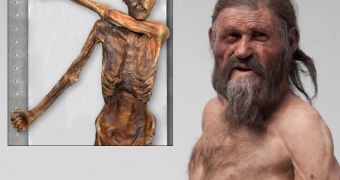A new investigation conducted on DNA samples collected from Ötzi, a Neolithic Tyrolean iceman, reveals that he was the first known human to carry Lyme disease. A team of experts managed to sequence man's DNA, and made a host of interesting discoveries.
This particular fossil is one of the best-studied in the world. It was discovered 21 years ago in the Alps, as the glacier that had trapped him for thousands of years was melting. Since that time, he was subjected to a wide array of experiments and studies.
One of the most significant discoveries was that the man suffered from arteriosclerosis before he died. This is a condition where the arteries harden due to risk factors such as obesity, smoking, drinking, lack of physical exercise and so on.
However, none of these existed at the time Ötzi lived. What this suggests is that our circulatory system may in fact be a lot frailer than what we give it credit for. In other words, we may not be able to prevent the condition from occurring even if we tried to quit all our nasty habits.
What the DNA sequencing process revealed was that the iceman had a genetic predisposition towards developing this condition. Details of the research were published in the latest issue of the top scientific journal Nature Communications.
When experts sequenced his Y chromosome, they found that the iceman has very few genetic markers that match those of existing populations. He was most similar to the ancestors of people currently living in Corsica, Sardinia, and some remote parts of Georgia and the Russian Federation.
Ötzi is part of the G2A4 haplogroup, meaning that his ancestors were among the Homo sapiens that left the Near East for Europe. This migration is believed to have occurred roughly 1,000 years before Ötzi himself lived, Science Now reports.
At the time of his death, the man was about 1.65 meters (5 feet 5 inches) tall, weighed 50 kilograms (110 pounds), and was about 45 years old. Data collected from his tooth enamel, and from dust and pollen grains found nearby suggested he grew up near the present village of Feldthurns, Italy.
The new study also helps with his description. It is now believed that Ötzi had brown eyes and brown hair, type-O blood, and was lactose-intolerant. At that time, most humans living in Europe displayed this condition.
The DNA of the Borrelia burgdorferi bacterium was also found in him, suggesting that he carried Lyme disease. Experts will now compare the pathogen's genetic material with modern strains, in order to determine how the microorganism evolved.

 14 DAY TRIAL //
14 DAY TRIAL //